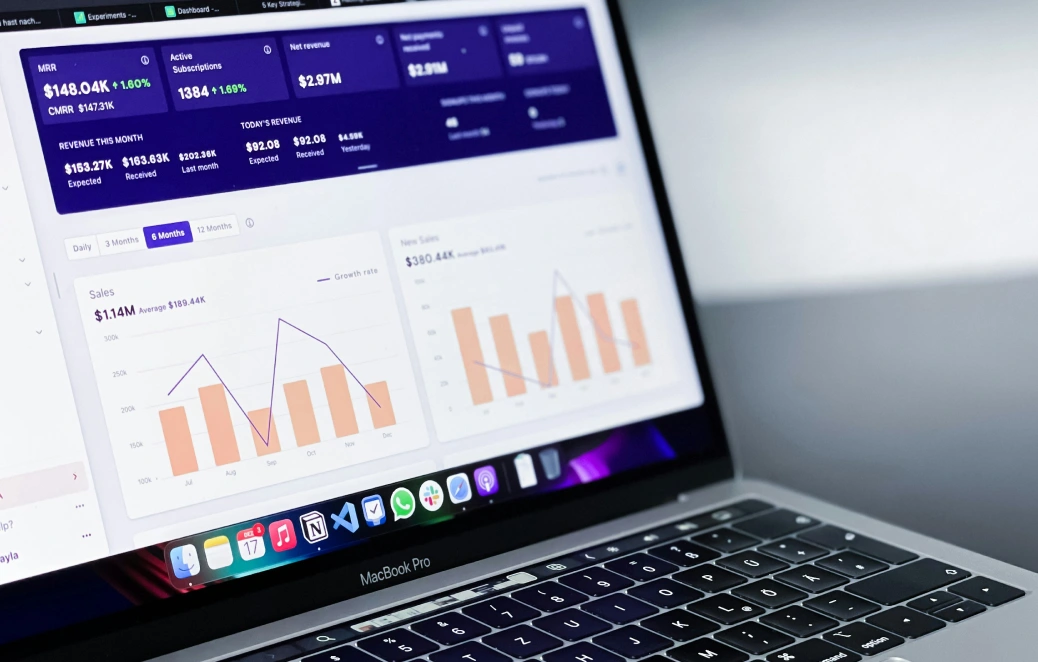Tips to Measure ROI From Your Conference Production Company

Chief Executive Officer

Want to know if your conference was worth the investment? Here's how to measure ROI effectively.
Measuring the return on investment (ROI) for your event means analyzing the financial and non-financial outcomes against the costs. It’s not just about ticket sales - it’s about tracking leads, brand visibility, and attendee satisfaction. Start by setting clear goals, using SMART objectives, and tracking key metrics like lead quality, engagement, and revenue.
Key steps include:
- Define SMART goals: Set specific, measurable, and time-bound objectives.
- Track costs: Separate fixed (venue, A/V) and variable (catering, staffing) expenses.
- Monitor KPIs: Focus on metrics aligned with your goals (e.g., leads, social mentions, or sales).
- Calculate ROI: Use the formula:
((Total Benefits - Total Costs) / Total Costs) x 100. - Leverage tools: Use platforms like CRMs, event management tools, and analytics software to streamline tracking.
A Strategic Approach to Event ROI Measurement
Setting Event Goals and Key Metrics
To measure the ROI of your event, you need to start with clear, measurable objectives that align with your business priorities. Without this groundwork, it’s nearly impossible to evaluate whether your investment in conference production truly paid off.
Begin by defining your business goals. Are you looking to boost brand awareness, drive traffic, increase sales, or strengthen customer loyalty? Each goal will shape how you plan and measure your event’s success.
Creating SMART Objectives
The SMART framework is a powerful way to turn vague ambitions into actionable, trackable goals. SMART stands for Specific, Measurable, Achievable, Relevant, and Time-bound.
For example, instead of saying, "We want more leads", a SMART objective would be: "Generate 250 qualified leads within 30 days, with at least 40% expressing interest in our new product line." This clarity makes it easier to track progress and determine if the event was worth the investment.
Here’s how each SMART element applies to conference goals:
- Specific: Clearly outline what you want to achieve. Instead of “improve brand visibility,” say, “increase social media mentions by attendees and speakers.”
- Measurable: Use numbers to set precise targets, like “collect 300 new email subscribers” or “achieve an average satisfaction score of 4.2 out of 5.0.”
- Achievable: Set realistic goals based on your resources and past performance. For instance, if your last event generated 150 leads, aiming for a 33%-67% increase is reasonable.
- Relevant: Ensure your objectives align with your business needs. If you’re launching a new product, prioritize goals like product demo attendance over general networking metrics.
- Time-bound: Define clear deadlines, whether you’re measuring results immediately, within 30 days, or over a longer period like 90 days.
Once your objectives are SMART, you can align the metrics you’ll use to track them.
Choosing the Right KPIs
With SMART objectives in place, the next step is selecting the right KPIs (Key Performance Indicators) to measure success. Different event goals call for different metrics, and a mix of quantitative and qualitative data will give you the most complete picture.
- For brand awareness: Track social media mentions, website traffic spikes, and media coverage. Look at hashtag usage, engagement on LinkedIn posts from attendees, and any earned media from the event.
- For lead generation: Focus on the number of new contacts from registrations, badge scans, and follow-up responses. Go beyond quantity - evaluate how many of those leads match your ideal customer profile.
- For sales-focused events: Measure direct revenue generated during the event and follow-up sales within your set timeframe. This includes immediate purchases as well as deals that progress in your sales pipeline due to event connections.
- For customer engagement: Monitor session attendance rates, participation in polls or Q&A sessions, and attendee feedback scores. Pay attention to how long people stay at your presentations and whether they explore multiple event touchpoints.
The best approach combines hard numbers with qualitative insights. For instance, while 200 new leads might sound impressive, knowing that 150 of them are decision-makers makes it far more valuable. Similarly, a 4.5 satisfaction score carries more weight when paired with specific feedback about which aspects of the event attendees enjoyed most.
To get the most out of your production investment, focus on KPIs that align with your goals. Whether it’s interactive tech to boost engagement or a standout booth design to capture leads, your efforts should directly support what matters most to your business.
Recording Costs and Collecting Data
Keeping accurate records of expenses and gathering detailed event data are essential for measuring ROI effectively. Without a clear picture of what you’re spending and how your event performs, it’s nearly impossible to calculate meaningful returns. Start tracking costs and collecting data from the planning phase all the way through post-event activities.
Breaking Down Event Costs
To understand your event costs, you need to separate them into fixed and variable categories. Fixed costs - like venue rentals, entertainment bookings, or subscriptions for event registration software - stay the same no matter how many people attend. Variable costs, on the other hand, such as catering and staffing, change depending on the number of attendees.
Here are some of the key expenses to account for:
- Venue & Facilities: Include costs for venue rentals, meeting spaces, changes to room setups, power connections, rigging points, and rented items like tables, chairs, and linens.
- Food & Beverage: Cover meals, coffee breaks, networking dinners, service charges, and sales tax. On average, venue and catering expenses make up 40% to 60% of a conference budget.
- Audio-Visual & Production: Factor in rentals for projectors, monitors, cameras, microphones, and livestreaming services. Don’t forget A/V staffing costs, internet connectivity, and external production fees.
- Marketing & Promotion: Allocate 15% to 20% of your budget for advertising, speaker fees, promotional materials, and digital marketing efforts.
Additionally, set aside a contingency fund - around 10% to 15% of your total budget - for unexpected expenses. To avoid budget surprises, request clear, all-inclusive quotes from vendors upfront.
Budgeting is critical, especially since conference costs can range from $150,000 to over $3,000,000 depending on factors like size, location, and duration. Even minor missteps can lead to significant overruns.
Once you’ve outlined your expenses, the next step is to pair them with detailed performance data to complete your ROI analysis.
Data Collection Methods
Tracking event costs is only half the equation. You also need to gather data that shows how your event performed. Data collection should begin before the event starts and continue through to post-event follow-up.
- Registration Platforms: Use registration systems to collect attendee demographics, job titles, company information, and session preferences. This provides a baseline understanding of your audience and their interests.
- Audience Engagement Tools: Tools like polling apps, Q&A platforms, and check-in systems can give you real-time feedback on participation and session engagement.
- Badge Scanning Technology: Track attendee movements at booths, sessions, and networking areas. This helps you map out their journeys and pinpoint key touchpoints.
- Post-Event Surveys: Send surveys within 24 to 48 hours of the event while it’s still fresh in attendees’ minds. Focus on satisfaction scores, content quality, and overall feedback.
- Website and Social Media Analytics: Monitor spikes in website traffic, social media mentions, hashtag usage, and content engagement to assess the broader impact of your event.
- Corporate Optics' Post-Event Analytics: Tools like Corporate Optics provide a streamlined way to consolidate data and turn it into actionable insights, giving you a full picture of performance across all touchpoints.
To make data collection seamless, set up tracking systems in advance, train your team on how to gather data effectively, and follow up consistently. With detailed cost tracking and thorough performance data, calculating ROI becomes much simpler and more accurate.
Computing ROI and Understanding Results
After tracking all your costs and gathering performance data, the next step is to analyze the numbers. This helps you determine if your event was financially successful and identify areas that could be improved. Essentially, it connects your expenses to the outcomes you achieved.
ROI Formula with Example
The formula for calculating ROI is:
ROI = ((Total Benefits - Total Costs) / Total Costs) x 100.
This percentage shows how much return you generated for every dollar spent.
"Return on investment (ROI) is a performance measure used to evaluate the efficiency or profitability of an investment."
Let’s take an example: If your event brought in $50,000 in revenue and your total costs were $30,000, the calculation would look like this:
(($50,000 - $30,000) / $30,000) = 0.67, or 67%.
This means your organization earned $0.67 for every dollar spent - an indication of a strong return.
When calculating ROI for your event, make sure to account for all revenue sources, such as registration fees, sponsorships, exhibitor booth sales, merchandise, and any direct sales made during the event. Don’t forget to include potential pipeline revenue from leads that could result in future sales.
On the expense side, go beyond the obvious costs. Include staff hours for planning and execution, opportunity costs for internal resources, follow-up activities after the event, and hidden costs like overtime or last-minute fixes.
"ROI is a popular metric because of its versatility and simplicity. Essentially, ROI can be used as a rudimentary gauge of an investment's profitability."
Measuring Non-Financial Benefits
Not all event outcomes are tied to dollars and cents. Some of the most valuable results - like boosting brand awareness, improving attendee satisfaction, or building strategic partnerships - are harder to measure but critical for long-term success.
"Event ROI (Return on Investment) is the single most important metric for knowing, in plain terms, if an event actually delivered value in terms of revenue, relationships, reputation, or results."
To include these intangible benefits in your ROI assessment, you can assign monetary values where possible. For instance, if your event gained 1,000 new social media followers, estimate their value based on typical conversion rates and average customer spending. If 2% of those followers become customers and spend $500 each, those followers represent $10,000 in potential revenue.
Other ways to quantify non-financial benefits include:
- Estimating brand exposure by comparing it to the cost of achieving similar reach through advertising.
- Evaluating lead quality by comparing how well event-generated leads convert compared to other sources.
- Assessing the long-term revenue impact of new partnerships or relationships formed during the event.
- Factoring in the effects of high attendee satisfaction, such as better repeat attendance and referrals, which can reduce future marketing costs.
The trick is to stay consistent and conservative in your estimates. By avoiding inflated numbers, you’ll provide stakeholders with credible ROI figures, helping them make better decisions for future events.
sbb-itb-ae35a94
Using Tools and Services for ROI Measurement
Tracking event ROI becomes much more manageable when you have the right tools working together. The key is to choose platforms that integrate smoothly, offering the data you need without unnecessary complications. This combination of financial tracking and engagement metrics sets the foundation for effective ROI measurement.
Recommended Tools and Platforms
Customer Relationship Management (CRM) systems are essential for keeping tabs on ROI. Tools like HubSpot and Salesforce CRM allow you to follow leads from their first interaction to the final sale. This makes connecting event attendance to revenue much easier. Pair these with event management platforms like Eventbrite, Cvent, or Stova, which handle registration, engagement tracking, and real-time analytics. These platforms often sync with your CRM to ensure attendee data flows seamlessly.
For audience engagement tracking, specialized tools can measure participation during your event. Features like live polling, session attendance tracking, and Q&A participation give you hard numbers to assess engagement ROI.
When it comes to monitoring expenses, financial tracking software like QuickBooks or event-specific budgeting tools can help you stay on top of costs. These tools make it easy to track spending in real time, including any last-minute changes that might impact your ROI calculations.
If your event drives online activity, web analytics tools like Google Analytics are invaluable. They help you track website visits, form submissions, and content downloads triggered by your event. This data provides additional layers to your ROI analysis, ensuring nothing is overlooked.
Together, these tools create a complete system for tracking your event's performance, capturing everything from financials to engagement metrics.
Corporate Optics offers integrated post-event analytics that consolidate data to reveal attendee behavior and engagement trends. Their approach simplifies ROI measurement by focusing on the metrics that matter most to your goals. Additionally, working with a professional event production company like Corporate Optics ensures your tracking systems are set up correctly from the start. With their expertise in corporate events, leadership conferences, and shareholder meetings, they align data collection with your business objectives.
The best strategy is to focus on tools that work well together rather than trying to use every available option. Start with the essentials - lead tracking, expense monitoring, and engagement measurement - and expand as needed.
Finally, remember that even the best tools are only effective if your team uses them consistently. Systems that are too complex can lead to incomplete data and missed insights. Choose platforms that are user-friendly and provide clear, actionable information without overwhelming your team.
Improving Future Events with ROI Data
Measuring ROI isn’t just about crunching numbers - it’s about using those insights to make your next event even better. By diving into ROI data, you can pinpoint areas to improve, boosting both attendee satisfaction and profitability. These insights give you a clear path to refine your approach for future events.
Comparing Results and Spotting Opportunities
Take a close look at past events to identify where things can improve. Metrics like cost per attendee, lead conversion rates, and engagement scores can reveal patterns. For example, if engagement consistently drops during afternoon sessions or certain types of content generate more leads, you’ve got a clear direction for adjustments.
While event ROI benchmarks vary by industry and type, the real focus should be on improving your own results. Instead of chasing industry averages, aim to outperform your previous events.
Feedback plays a crucial role here. If attendees frequently comment on session length, networking opportunities, or logistical issues, these should become priorities for your next event. Sometimes, feedback uncovers areas that raw financial data might overlook.
Session attendance data can also provide valuable insights. If attendees leave midway through certain sessions, it might point to issues with content or format. On the flip side, sessions that keep people engaged from start to finish can serve as a model for future planning. Pay attention to which topics, speakers, and formats maintain interest, and use those elements to shape your next event.
Turning Data into Action
Once you’ve analyzed your data, it’s time to make informed changes. Let the numbers guide your decisions rather than relying on guesswork. For instance, if morning sessions consistently show higher engagement and lead quality, consider scheduling your most important content earlier in the day.
ROI insights also help you make smarter budget decisions. If certain expenses don’t seem to impact attendee satisfaction or lead generation, redirect that money toward areas that deliver results - like better audiovisual setups or interactive technology.
Speakers and content that consistently perform well should be prioritized. If a speaker gets rave reviews and drives audience participation, they should be at the top of your list for future events. Similarly, formats that clearly boost lead generation, brand awareness, or customer retention should take center stage in your programming.
Instead of overhauling everything at once, focus on making small, targeted improvements. Try one change per event cycle and measure its impact before moving forward. This step-by-step approach helps you figure out what’s working without introducing too many variables at once.
Documenting the outcomes and decisions from each event is equally important. It ensures you don’t repeat mistakes and makes future planning more efficient.
Conclusion: Getting the Most from Conference Production Services
Measuring the ROI of your conference production company lays the groundwork for smarter, more profitable events. The strategies shared here offer a clear path to making the most of your production investments and creating events that truly drive business results.
Set clear objectives from the start. Using SMART goals as your framework helps you define success and align event strategies with your business priorities. Whether your focus is lead generation, increasing brand visibility, or enhancing attendee satisfaction, these goals guide every decision and ensure your event stays on track. Once your objectives are set, the next step is keeping a close eye on every expense.
Track all expenses with precision. Categorizing costs like production fees, venue charges, technology, marketing efforts, and staffing gives you the complete financial picture you need for accurate ROI calculations.
Combine quantitative and qualitative metrics to evaluate success. Concrete numbers, such as revenue and leads, provide measurable ROI - imagine an event costing $15,000 that generates $51,000 in business value, achieving a 240% ROI. But don’t overlook qualitative data like attendee satisfaction and engagement. These insights offer a broader view of your event’s impact and help justify future investments.
Use event platforms equipped with robust analytics. Tools with real-time feedback, built-in reporting, and post-event analytics - like those offered by Corporate Optics - make it easier to consolidate data and extract actionable insights for future planning.
Finally, let your data guide your decisions. Over half of CEOs agree that event marketing delivers higher ROI than other marketing channels. Regularly reviewing performance metrics allows you to fine-tune content, allocate budgets more effectively, and enhance attendee experiences for even better outcomes.
FAQs
How do I set and track SMART goals to measure ROI for my conference?
To effectively set and track SMART goals for your conference, start by pinpointing clear, measurable objectives that directly support the purpose of your event. The SMART framework - Specific, Measurable, Achievable, Relevant, and Time-bound - is a great tool to ensure your goals are well-defined and actionable.
Key metrics to consider include attendee engagement, the number of strategic meetings held, revenue generated or influenced by the event, and cost management efficiency. Keep an eye on these metrics not just during the event but also afterward to evaluate performance and identify areas for improvement. By tying your objectives to measurable results, you’ll be able to assess ROI more effectively and refine your conference strategy for even better outcomes in the future.
What are some non-financial benefits of working with a conference production company, and how can they be measured?
When you team up with a conference production company, the benefits often go beyond just financial gains. You can see boosts in areas like brand reputation, customer loyalty, employee morale, and even market reach. These are the kinds of wins that can shape how people perceive your business and strengthen relationships with both customers and employees.
To measure these impacts, tools like post-event surveys, brand perception studies, and social media analytics come in handy. For instance, tracking social media mentions, shares, and comments can reveal how well your event struck a chord with the audience. Meanwhile, feedback forms and attendee polls offer valuable insights into whether the event hit its goals, giving you a clearer picture of its overall success and influence.
What are the best tools for measuring the ROI of a conference event?
To gauge the ROI of a conference event, leveraging the right tools can make all the difference. Event management software with built-in ROI tracking features is a great starting point. These platforms often focus on attendee engagement and cost analysis, offering a clear picture of how your event performs financially.
Another must-have? Marketing attribution tools. These help connect event activities directly to revenue, making it easier to see which efforts are driving results.
Don’t overlook survey tools either. Collecting attendee feedback provides valuable insights into engagement and satisfaction - two critical measures of an event's success. By combining these tools, you’ll gain a well-rounded view of your event’s financial returns, attendee impact, and overall performance.
Related Blog Posts









